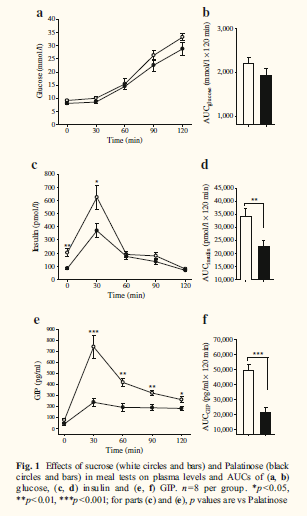By popular demand @Karim_Wassef … 
Results: Glucose homeostasis and incretin response to sucrose and Palatinose Oral challenge with the experimental sugars revealed that exposure to sucrose solutions induced a remarkable acute increase in glucose, insulin and GIP levels, without effects on GLP-1 secretion, which were avoided with Palatinose (ESM Fig. 1a–h). https://link.springer.com/article/10.1007/s00125-014-3423-5
This is going to need a little explaining.
Sucrose (table sugar) is made up of glucose and fructose. Palatinose a brand name of isomaltulose. It is also made up of glucose and fructose, but the fructose is hidden away by way of some tricky science voodoo in the construction of the molecule. So… what happens when you compare the effects of ingesting these two things? It should show you the fructose effects sepatrate from the glucose effects.
Take a look at the figure from the study below:
-
The two sugars have simialar glucose response curves. This is because fructose by itself does not do much to blood glucose.
-
The sugar with an active fructose component raises insulin more. Fructose by itself does not raise insulin levels. So why the increase? …
-
Fructose acts upon the GIP sensors in your stomach to potentiate a higher insulin response to the same amount of glucose in the sugar. Remember, regular starches are broken down into glucose too by amylase in the saliva. GIP acts directly on the pancreas beta cells (including insulin and glucagon), bone, fat, gastrointestinal (GI) tract and brain. https://www.ncbi.nlm.nih.gov/pmc/articles/PMC4020673/
That’s not to say that fructose in isolation doesn’t cause other problems, like increased triglycerides. https://www.ncbi.nlm.nih.gov/pubmed/15181085
Note:
Glucose and fructose from both disaccharides are completely digested and absorbed, just not at the same zone of the small intestines. This difference has completely opposite effects on metabolism kick responses. Fructose still has a small effect on the pancreas in the bloodstream. (Thx @erdoke ) https://www.ncbi.nlm.nih.gov/pubmed/22315413


